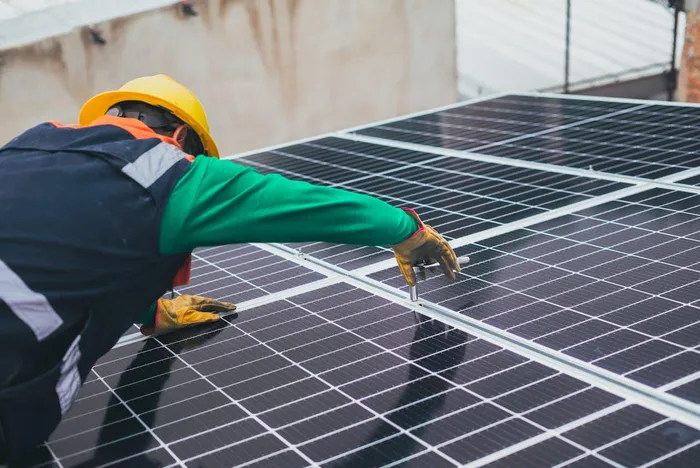The age of grid defection is upon us as solar and battery systems become more affordable- Sapvia

To cover 100% of your supply with solar and batteries can be challenging, says Sapvia.
Image: Pexels
Solar and battery systems have got so cheap that many private individuals, farmers and companies are waking up to the fact that in many locations in South Africa it is now less expensive to be off the electrical grid than to be on it.
This has been driven by two key factors: First is the rapidly rising cost of electricity supplied by Eskom and municipalities in South Africa, where tariffs have increased above inflation every year for the last 17 years. The second has been the rapidly declining cost of photovoltaic (PV) solar panels and lithium batteries over the same period of time, with manufacturing volume of such growing exponentially each year, always exceeding even the most optimistic projections.
Until recently installing solar and battery systems was done to save money during the daytime (due to the super-cheap solar electricity production), and to protect against loadshedding (through the battery component).
But for many locations in South Africa, it is now possible to generate electricity from such systems that can cover not only the daytime demand of a consumer, but the night-time demand as well, to such an extent that remaining on the grid is no longer necessary.
This is further being driven by the fact that the fixed costs to actually bring the wires to properties are now going up significantly faster than the energy charges to bring you electricity over those same wires. So why have the wires at all?
Yet it is true that to cover 100% of your supply with solar and batteries can be challenging. There are two cost effective ways to mitigate against this. One is to install a backup petrol/diesel generator, whose occasional use may be expensive, but the blended cost of the solar and batteries and generator and fuel could still be less than the cost to buy from the grid. The other is to switch to an Electric Vehicle (EV), which can act as the backup to the solar battery system, and be recharged on the grid if need be.
The sunnier the location, and the higher the electricity tariff, the better the economics of grid defection can be, thus this growing trend is more predominant in the Northern part of South Africa.
But this raises the important question of “Where does this leave Eskom?”, which arguably is too big to fail, and on which many who cannot afford solar battery systems are completely dependent. Those who leave Eskom raise the costs of electricity for others. Another corollary question could be “Is leaving the grid the right thing to do?”
At the South African Photovoltaic Association (Sapvia) we believe that the primary source of Africa and South Africa’s energy will be the sun (which also drives the wind and water systems that provide energy), including low cost solar and battery systems. However, it is also clear that the optimal delivery of low-cost power across South Africa should be done by a combination of solar, wind and battery systems, of all scales, but these linked together by a modern transmission grid network. Such a distributed smart-grid can delivery reliable, affordable, clean electricity across the country.
Private off-grid systems are, in some senses, inefficient, as any extra they could produce, that isn’t used, could theoretically be shared with the grid. Furthermore, economies of scale mean that extra large solar and battery systems could provide lower cost electricity than small, private systems.
So perhaps leaving the grid isn’t the right thing to do, but what does one do in the face of a Utility that has not yet fully adopted the change required to morph into a utility of the future?
Fortunately, government regulation is pushing Eskom in the right direction. Eskom is being broken up into three separate entities, being Generation (the entity holding all the current coal and nuclear power stations, with ambitions to build many GWs of Renewables), Transmission (the entity running all the large high voltage overhead power lines criss-crossing the country), and Distribution (the entity bring the low voltage wires to the meters of most of Eskom’s customers). Transmission and Distribution are currently viable businesses, but Generation is not, and this is the heart of Eskom’s cost problems. However, as more and more cheap renewables is built, both by Eskom and the private sector, this can be addressed and managed, as the scale of this low cost generation eclipses Eskom’s challenges
In addition the South African Wholesale Electricity Market (Sawem) is to be launched next year, and implemented over the course of three to four years. This will allow the private sector to compete on a fair footing to provide the lowest cost electricity in each hour of the day, and use well structured market forces to bring the lowest cost, cleanest electricity on to the grid.
But a number of challenges remain. We need to ramp up the build rate of solar and wind from the few GWs per year currently happening, to perhaps to five times that, in order to allow for economic growth and successfully realising ambitions of the South African Renewable Energy Masterplan With this comes a tremendous opportunity to grow skills, jobs and economic development in South Africa, as well as to manage the energy transition,
We also need to solve that the tariff structuring of Eskom and municipalities has reached the point where it is becoming more cost effective to leave the grid completely, a non-optimal solution. Competition needs to be introduced into this Distribution space, where currently Eskom and the municipalities have monopolies over their customers, and customers that produce their own electricity are frowned upon. This approach needs to change completely, where the value of Prosumers, consumers that buy and sell to the grid, and their grid-connected solar battery systems are properly recognised.
These are not minor issues, but Sapvia remains confident that these can be solved. With the help of renewables, we have got out of loadshedding. Government policy for the last 25 years has slowly been bringing us in the right direction. What remains is for all to keep pushing towards always available, cleaner, low-cost electricity for all, and a growing economy in our sunny land.

Frank Spencer, a spokesperson of Sapvia.
Image: Supplied
Frank Spencer is a spokesperson at Sapvia.
*** The views expressed here do not necessarily represent those of Independent Media or IOL
BUSINESS REPORT